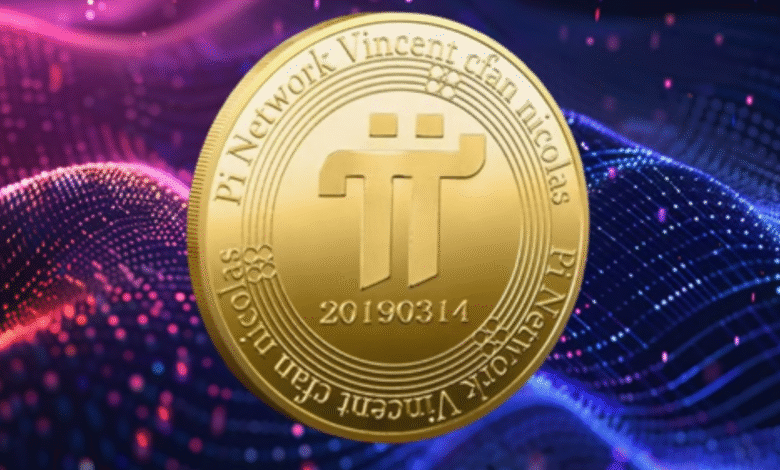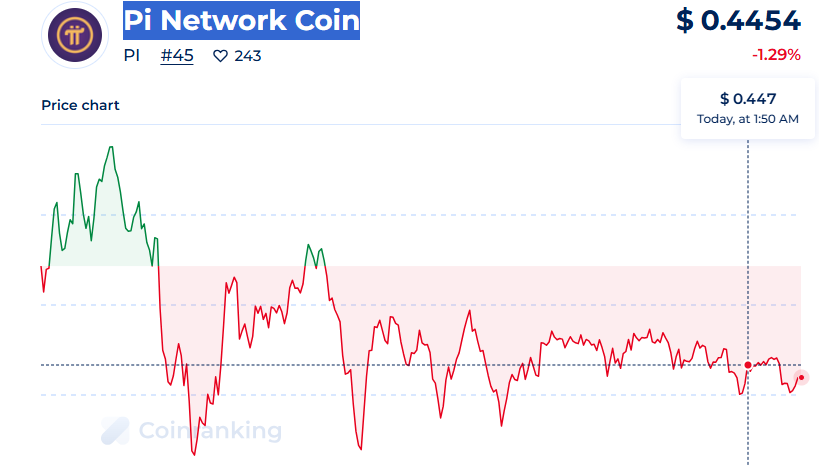Buy Pi Coin After Main-net Launch Complete Guide to Trading Pi Network Cryptocurrency

The historic Pi Network mainnet launch on February 20, 2025, has forever transformed the cryptocurrency landscape. After years of anticipation, Pi coin holders can now discover where to buy Pi coin through legitimate exchanges and trading platforms following the mainnet launch. This comprehensive guide reveals the most trusted locations, step-by-step purchasing processes, and essential security measures for acquiring Pi Network cryptocurrency.
With over 110 million verified users and Google search interest reaching record highs, understanding where to buy Pi coin after the mainnet launch has become crucial for both newcomers and experienced cryptocurrency investors. The transition from the closed network to the open mainnet has unlocked real-world trading opportunities, making Pi coin accessible through multiple verified exchanges and platforms worldwide. Whether you’re a first-time crypto buyer or an experienced trader looking to add Pi coin to your portfolio, this guide provides everything you need to know about purchasing Pi Network cryptocurrency safely and efficiently in the post-mainnet era.
Top Exchanges Where to Buy Pi Coin After Mainnet Launch
Major Cryptocurrency Exchanges Supporting Pi Coin
Following the mainnet launch, several reputable cryptocurrency exchanges have begun supporting Pi coin trading. The most prominent platforms include:
OKX Exchange stands as the leading platform for Pi coin trading, offering the highest trading volume and liquidity. This established exchange provides advanced trading features, competitive fees, and robust security measures for Pi Network transactions.
Bitget has emerged as another reliable option, featuring user-friendly interfaces and comprehensive trading tools. The platform offers both spot and futures trading for Pi coin, catering to different investment strategies and risk tolerances.
Gate.io provides extensive Pi coin trading pairs and supports multiple fiat currencies, making it accessible for international users. Their advanced order types and trading analytics make it suitable for both beginners and professional traders.
Decentralized Exchanges (DEX) for Pi Coin Trading
Decentralized exchanges offer an alternative approach for those seeking non-custodial trading options. Several DEX platforms have integrated Pi coin support:
PancakeSwap and Uniswap have added Pi coin liquidity pools, enabling direct peer-to-peer trading without the need for intermediary control. These platforms require users to connect their Web3 wallets and manage their private keys.
SushiSwap provides additional liquidity options and yield farming opportunities for Pi coin holders looking to earn passive income through decentralized finance protocols.
How to Buy Pi Coin After Mainnet Launch: A Step-by-Step Guide
Account Setup and Verification Process
Before purchasing Pi coin, you’ll need to complete the account verification process on your chosen exchange:
- Registration: Create an account using a valid email address and a strong password
- Identity Verification: Complete KYC (Know Your Customer) requirements by uploading government-issued identification
- Two-Factor Authentication: Enable 2FA for enhanced account security
- Bank Account Linking: Connect your bank account or credit card for fiat currency deposits
Deposit Methods and Payment Options
Most exchanges supporting Pi coin accept various payment methods:
Credit and Debit Cards offer the fastest purchase option, though they typically carry higher fees ranging from 2.5% to 5%. This method provides instant fund availability for immediate Pi coin purchases.
Bank Transfers provide lower fees (usually 1-2%) but require 1-3 business days for processing. ACH transfers and wire transfers are commonly supported options for larger purchases.
Cryptocurrency Deposits allow you to trade existing digital assets for Pi coin. Bitcoin, Ethereum, and USDT are widely accepted for Pi coin exchanges.
PayPal and Digital Wallets are increasingly supported by major exchanges, offering convenience for users preferring alternative payment methods.
Best Pi Coin Wallets for Secure Storage
Hardware Wallets for Pi Coin
Hardware wallets provide the highest security level for long-term Pi coin storage:
Ledger Nano S Plus and Ledger Nano X support Pi coin storage through their native blockchain integration. These devices store private keys offline, protecting against online threats and hacking attempts.
Trezor Model T offers comprehensive Pi coin support with an intuitive touchscreen interface. The device features advanced security protocols and backup recovery options.
Software Wallets and Mobile Apps
For active trading and daily transactions, software wallets provide convenient access:
Pi Network Official Wallet serves as the primary storage solution, offering seamless integration with the Pi ecosystem and native blockchain features.
MetaMask and Trust Wallet offer multi-currency support, allowing Pi coin storage alongside other cryptocurrencies within a single interface.
Exodus Wallet offers a user-friendly design with built-in exchange features, allowing direct Pi coin trading within the wallet application.
Pi Coin Price Analysis and Market Trends

Current Pi Coin Market Performance
Pi coin’s market performance following the mainnet launch has shown significant volatility and growth potential. Initial trading prices ranged from $0.40 to $2.99, reflecting market uncertainty and speculation about the project’s long-term viability.
Trading volume has increased substantially, with daily volumes exceeding $149 million on major exchanges. This liquidity improvement has reduced price spreads and enabled more efficient trading for both retail and institutional investors.
Market capitalization calculations vary depending on circulating supply estimates, but current projections place Pi coin among the top 50 cryptocurrencies by market value.
Price Prediction and Future Outlook
Industry analysts present diverse perspectives on Pi coin’s future price trajectory:
Conservative Estimates suggest Pi coin could reach $1.50-$3.00 by the end of 2025, based on network adoption rates and ecosystem development progress.
Optimistic Projections indicate potential prices of $5.00-$10.00 within 2-3 years, assuming successful mainstream adoption and the establishment of enterprise partnerships.
Technical Analysis reveals strong support levels around $0.50 and resistance near $2.00, with breakout potential dependent on broader cryptocurrency market conditions.
Security Considerations When Buying Pi Coin
Exchange Security Features
When selecting where to buy Pi coin after the mainnet launch, prioritize platforms with robust security measures:
Cold Storage Protection ensures that most user funds remain offline and protected from potential hacking attempts. Reputable exchanges store 95% or more of customer assets in cold wallets.
Insurance Coverage provides additional protection against potential losses due to security breaches or platform failures. Leading exchanges maintain comprehensive insurance policies for customer funds.
Regulatory Compliance indicates that the exchange operates under proper licensing and oversight, reducing risks associated with unregulated platforms.
Personal Security Best Practices
Protecting your Pi coin investments requires implementing strong personal security measures:
Unique Passwords should be used exclusively for cryptocurrency-related accounts, combined with two-factor authentication for maximum protection.
Phishing Awareness helps identify fraudulent websites and emails attempting to steal login credentials or private keys.
Regular Security Audits of your accounts and devices ensure that potential vulnerabilities are identified and addressed promptly.
Pi Coin Trading Strategies and Investment Tips

Dollar-Cost Averaging (DCA) Strategy
Dollar-cost averaging represents one of the most effective approaches for Pi coin investment:
This strategy involves making regular purchases regardless of price fluctuations, reducing the impact of market volatility on your overall investment. Weekly or monthly Pi coin purchases help smooth out price variations and reduce emotional trading decisions.
Implementation requires setting up automated purchases through your chosen exchange, specifying the purchase amount and frequency. Most major platforms support recurring buy orders for consistent DCA execution.
Technical Analysis for Pi Coin Trading
Understanding technical indicators helps optimize entry and exit points:
Moving Averages provide trend direction insights, with 50-day and 200-day averages commonly used for Pi coin analysis. Crossover patterns often signal potential changes in trend.
RSI (Relative Strength Index) indicates overbought or oversold conditions, helping to identify optimal buying opportunities when the RSI falls below 30 or selling signals are given above 70.
Volume Analysis confirms price movements and identifies accumulation or distribution phases in Pi coin trading patterns.
Regulatory Considerations and Legal Compliance
Global Regulatory Landscape
Pi coin trading operates within varying regulatory frameworks across different jurisdictions:
The United States classifies Pi coin as a digital asset subject to securities regulations, requiring exchanges to maintain proper licensing and reporting standards.
European Union has implemented comprehensive cryptocurrency regulations through MiCA (Markets in Crypto-Assets), providing clear guidelines for Pi coin trading platforms.
The Asia-Pacific region shows a mixed approach, with some countries embracing Pi coin trading while others maintain restrictive policies that require careful compliance assessment.
Tax Impl Trading. Complying with trading tax obligations ensures compliance with local revenue authorities:
Capital Gains Tax applies to profits from Pi coin trading activities, with rates varying based on holding periods and local tax laws.
Income Tax considerations affect Pi coin mining rewards and staking income, requiring proper documentation and reporting procedures.
Record-keeping requirements mandate maintaining detailed transaction histories for accurate tax calculations and potential audit preparations.
Future Developments and Ecosystem Growth
Upcoming Pi Network Features
The Pi Network development team continues expanding ecosystem functionality:
The Smart Contract Platform will enable the development of decentralized applications (dApps), increasing Pi coin utility and demand through real-world use cases.
Enterprise Partnerships are being established with major corporations interested in blockchain integration and Pi coin adoption for business operations.
Payment Integration initiatives aim to enable Pi coin usage for everyday transactions, increasing practical utility and driving mainstream adoption.
Also Read: Pi Network Price Outperforms Bitcoin After Mainnet Launch?
Community Growth and Adoption Metrics
Pi Network’s community expansion indicators suggest positive long-term prospects:
User Base Growth continues accelerating, with daily new registrations exceeding 100,000 users and total verified members surpassing 110 million globally.
Developer Activity shows an increasing interest in Pi Network blockchain development, with numerous projects and applications at various stages of development.
Merchant Adoption rates are improving as businesses begin accepting Pi coin payments, creating real-world demand and utility for the cryptocurrency.
Top Exchanges Where to Buy Pi Coin After Mainnet Launch
Major Cryptocurrency Exchanges Supporting Pi Coin
Following the mainnet launch, several reputable cryptocurrency exchanges have begun supporting Pi coin trading. The most prominent platforms include:
OKX Exchange stands as the leading platform for Pi coin trading, offering the highest trading volume and liquidity. This established exchange provides advanced trading features, competitive fees, and robust security measures for Pi Network transactions.
Bitget has emerged as another reliable option, featuring user-friendly interfaces and comprehensive trading tools. The platform offers both spot and futures trading for Pi coin, catering to different investment strategies and risk tolerances.
Gate.io provides extensive Pi coin trading pairs and supports multiple fiat currencies, making it accessible for international users. Their advanced order types and trading analytics make it suitable for both beginners and professional traders.
Decentralized Exchanges (DEX) for Pi Coin Trading
Decentralized exchanges offer an alternative approach for those seeking non-custodial trading options. Several DEX platforms have integrated Pi coin support:
PancakeSwap and Uniswap have added Pi coin liquidity pools, enabling direct peer-to-peer trading without intermediary control. These platforms require users to connect their Web3 wallets and manage their private keys.
SushiSwap provides additional liquidity options and yield farming opportunities for Pi coin holders looking to earn passive income through decentralized finance protocols.
How to Buy Pi Coin After Mainnet Launch: Step-by-Step Guide

Account Setup and Verification Process
Before purchasing Pi coin, you’ll need to complete the account verification process on your chosen exchange:
- Registration: Create an account using a valid email address and a strong password
- Identity Verification: Complete KYC (Know Your Customer) requirements by uploading government-issued identification
- Two-Factor Authentication: Enable 2FA for enhanced account security
- Bank Account Linking: Connect your bank account or credit card for fiat currency deposits
Deposit Methods and Payment Options
Most exchanges supporting Pi coin accept various payment methods:
Credit and Debit Cards offer the fastest purchase option, though they typically carry higher fees ranging from 2.5% to 5%. This method provides instant fund availability for immediate Pi coin purchases.
Bank Transfers provide lower fees (usually 1-2%) but require 1-3 business days for processing. ACH transfers and wire transfers are commonly supported options for larger purchases.
Cryptocurrency Deposits allow you to trade existing digital assets for Pi coin. Bitcoin, Ethereum, and USDT are widely accepted for Pi coin exchanges.
PayPal and Digital Wallets are increasingly supported by major exchanges, offering convenience for users preferring alternative payment methods.
Best Pi Coin Wallets for Secure Storage
Hardware Wallets for Pi Coin
Hardware wallets provide the highest security level for long-term Pi coin storage:
Ledger Nano S Plus and Ledger Nano X support Pi coin storage through their native blockchain integration. These devices store private keys offline, protecting against online threats and hacking attempts.
The Trezor Model T offers comprehensive Pi coin support, featuring an intuitive touchscreen interface. The device features advanced security protocols and backup recovery options.
Software Wallets and Mobile Apps
For active trading and daily transactions, software wallets provide convenient access:
Pi Network Official Wallet serves as the primary storage solution, offering seamless integration with the Pi ecosystem and native blockchain features.
MetaMask and Trust Wallet offer multi-currency support, allowing Pi coin storage alongside other cryptocurrencies within a single interface.
Exodus Wallet offers a user-friendly design with built-in exchange features, allowing direct Pi coin trading within the wallet application.
Pi Coin Price Analysis and Market Trends
Current Pi Coin Market Performance
Pi coin’s market performance following the mainnet launch has shown significant volatility and growth potential. Initial trading prices ranged from $0.40 to $2.99, reflecting market uncertainty and speculation about the project’s long-term viability.
Trading volume has increased substantially, with daily volumes exceeding $149 million on major exchanges. This liquidity improvement has reduced price spreads and enabled more efficient trading for both retail and institutional investors.
Market capitalization calculations vary depending on circulating supply estimates, but current projections place Pi coin among the top 50 cryptocurrencies by market value.
Price Prediction and Future Outlook
Industry analysts present diverse perspectives on Pi coin’s future price trajectory:
Conservative Estimates suggest Pi coin could reach $1.50-$3.00 by the end of 2025, based on network adoption rates and ecosystem development progress.
Optimistic Projections indicate potential prices of $5.00-$10.00 within 2-3 years, assuming the successful establishment of stream adoption and enterprise partnerships.
Technical Analysis reveals strong support levels around $0.50 and resistance near $2.00, with breakout potential dependent on broader cryptocurrency market conditions.
Security Considerations When Buying Pi Coin
Exchange Security Features
When selecting where to buy Pi coin after the mainnet launch, prioritize platforms with robust security measures:
Cold Storage Protection ensures that most user funds remain offline and protected from potential hacking attempts. Reputable exchanges store 95% or more of customer assets in cold wallets.
Insurance Coverage provides additional protection against potential losses due to security breaches or platform failures. Leading exchanges maintain comprehensive insurance policies for customer funds.
Regulatory Compliance indicates that the exchange operates under proper licensing and oversight, reducing risks associated with unregulated platforms.
Personal Security Best Practices
Protecting your Pi coin investments requires implementing strong personal security measures:
Unique Passwords should be used exclusively for cryptocurrency-related accounts, combined with two-factor authentication for maximum protection.
Phishing Awareness helps identify fraudulent websites and emails attempting to steal login credentials or private keys.
Regular Security Audits of your accounts and devices ensure that potential vulnerabilities are identified and addressed promptly.
Pi Coin Trading Strategies and Investment Tips
Dollar-Cost Averaging (DCA) Strategy
Dollar-cost averaging represents one of the most effective approaches for Pi coin investment:
This strategy involves making regular purchases regardless of price fluctuations, reducing the impact of market volatility on your overall investment. Weekly or monthly Pi coin purchases help smooth out price variations and reduce emotional trading decisions.
Implementation requires setting up automated purchases through your chosen exchange, specifying the purchase amount and frequency. Most major platforms support recurring buy orders for consistent DCA execution.
Technical Analysis for Pi Coin Trading
Understanding technical indicators helps optimize entry and exit points:
Moving Averages provide trend direction insights, with 50-day and 200-day averages commonly used for Pi coin analysis. Crossover patterns often signal potential changes in trend.
The RSI (Relative Strength Index) indicates overbought or oversold conditions, helping to identify optimal buying opportunities when the RSI falls below 30 or selling signals are given above 70.
Volume Analysis confirms price movements and identifies accumulation or distribution phases in Pi coin trading patterns.
Regulatory Considerations and Legal Compliance
Global Regulatory Landscape
Pi coin trading operates within varying regulatory frameworks across different jurisdictions:
The United States classifies Pi coin as a digital asset subject to securities regulations, requiring exchanges to maintain proper licensing and reporting standards.
The European Union has implemented comprehensive cryptocurrency regulations through MiCA (Markets in Crypto-Assets), providing clear guidelines for trading platforms, including those for Pi coin.
The Asia-Pacific region shows a mixed approach, with some countries embracing Pi coin trading while others maintain restrictive policies that require careful compliance assessment.
Tax Implications of Pi Coin Trading. Complying with tax obligations ensures compliance with local revenue authorities:
Capital Gains Tax applies to profits from Pi coin trading activities, with rates varying based on holding periods and local tax laws.
Income Tax considerations affect Pi coin mining rewards and staking income, requiring proper documentation and reporting procedures.
Record-keeping requirements mandate maintaining detailed transaction histories for accurate tax calculations and potential audit preparations.
Future Developments and Ecosystem Growth
Upcoming Pi Network Features
The Pi Network development team continues expanding ecosystem functionality:
The Smart Contract Platform will enable the development of decentralized applications (dApps), increasing Pi coin utility and demand through real-world use cases.
Enterprise Partnerships are being established with major corporations interested in blockchain integration and Pi coin adoption for business operations.
Payment Integration initiatives aim to enable Pi coin usage for everyday transactions, increasing practical utility and driving mainstream adoption.
Community Growth and Adoption Metrics
Pi Network’s community expansion indicators suggest positive long-term prospects:
User Base Growth continues accelerating, with daily new registrations exceeding 100,000 users and total verified members surpassing 110 million globally.
Developer Activity shows an increasing interest in Pi Network blockchain development, with numerous projects and applications at various stages of development.
Merchant Adoption rates are improving as businesses begin accepting Pi coin payments, creating real-world demand and utility for the cryptocurrency.
Conclusion
Understanding where to buy Pi coin after the mainnet launch opens doors to participating in one of cryptocurrency’s most promising projects. With multiple reputable exchanges now supporting Pi coin trading, investors have numerous secure options for purchasing and storing their digital assets. The mainnet launch has transformed Pi coin from an experimental mobile mining project into a fully functional cryptocurrency with real-world trading capabilities. Whether you opt for centralized exchanges for convenience or decentralized platforms for maximum control, the key to success lies in prioritizing security, understanding market dynamics, and implementing effective investment strategies.
Ready to start your Pi coin investment journey? Research your preferred exchange, complete the verification process, and begin exploring where to buy Pi coin after the mainnet launch through trusted platforms today. Remember to start with small amounts while learning the platform features and always prioritize security over convenience.
FAQs
Q1: Is it safe to buy Pi coin after the mainnet launch?
Yes, buying Pi coin after the mainnet launch is generally safe when using reputable exchanges with compliance, security measures, regulatory compliance, and insurance coverage. Always verify exchange credentials and use strong security practices.
Q2: What’s the minimum amount of Pi coin I can purchase?
Most exchanges allow Pi coin purchases starting from $10 to $ 25, although the minimum amounts vary by platform. Some exchanges offer fractional Pi coin purchases, enabling small-dollar investments for beginners.
Q3: How long does it take to receive Pi coin after purchase?
Pi coin purchases typically complete within 5-15 minutes on most exchanges; however, bank transfer deposits may require 1-3 business days before the funds become available for trading.
Q4: Can I buy Pi coin with other cryptocurrencies?
Yes, most exchanges support Pi coin purchases using Bitcoin, Ethereum, USDT, and other major cryptocurrencies. This option often provides faster processing compared to fiat currency deposits.
Q5: Are there any geographical restrictions for buying Pi coin?
Some exchanges may restrict Pi coin trading based on local regulations. Users should verify their country’s eligibility and compliance requirements before attempting to purchase Pi coin.
